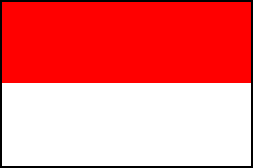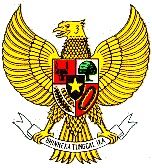
When World War II broke out in Europe and spread to the Pacific, the Japanese occupied the Dutch East Indies as of March 1942, after the surrender of the Dutch colonial army following the fall of Hong Kong, Manila and Singapore.
On April 1, 1945, American troops landed in Okinawa. Soon after, on August 6 and 9, the United States dropped Atom bombs on two Japanese cities, Hiroshima and Nagasaki. A few days later, on August 14, 1945, the Japanese surrendered to the Allied Forces.
That occasion opened the opportunity for the Indonesian people to proclaim their independence. Three days after the unconditional Japanese surrender, on August 17, 1945, the Indonesian national leaders Ir. Soekarno and Drs. Mohammad Hatta proclaimed lndonesia's independence on behalf of the people.
The proclamation was brief, concise and reads as follows:
|
PROCLAMATION WE, THE PEOPLE OF INDONESIA, DO HEREBY PROCLAIM
JAKARTA, AUGUST 17, 1945
|
The proclamation, which took place at 58, Jalan Pegangsaan Timur, Jakarta, was heard by thousands of Indonesians throughout the country because the text was secretly broadcast by Indonesian radio personnel using the transmitters of the Japanese-controlled radio station, JAKARTA Hoso Kyoku. An English translation of the proclamation was broadcast overseas.
 Back
Back
Pancasila, pronounced Panchaseela, is the philosophical basis of the Indonesian state. Pancasila consists of two Sanskrit words, "panca" meaning five, and "sila" meaning principle.
It comprises five inseparable and interrelated principles. They are:
Elaboration of the five principles is as follows:
1. Belief in the One and Only God
This principle of Pancasila reaffirms the Indonesian people's, belief that God does exist. It also implies that the Indonesian people believe in life after death. It emphasizes that the pursuit of sacred values will lead the people to a better life in the hereafter.
The principle is embodied in article 29, Section 1 of the 1945 Constitution and reads: "The state shall be based on belief in the One and Only God".
2. Just and Civilized Humanity
This principle requires that human beings be treated with due regard to their dignity as God's creatures. It emphasizes that Indonesian people do not tolerate physical or spiritual oppression of human beings by their own people or by any nations.
3. The Unity of Indonesia
This principle embodies the concept of nationalism, of love for one's nation and motherland. It envisages the need to always foster national unity and integrity. Pancasila nationalism demands that Indonesians avoid superiority feelings on ethnical grounds, for reasons of ancestry and color of the skin. In 1928, Indonesian youth pledged to have one country, one nation and one language, while the Indonesian coat of arms enshrines the symbol of "Bhinneka Tunggal Ika" which means "unity in diversity".
Social differences in daily life should never affect national unity and integrity. Referring to this question, President Soeharto once remarked: "What we should do is to have these differences blend us together in perfect harmony like the beautiful spectrum of the rainbow."
4. Democracy Guided by the Inner Wisdom in the Unanimity Arising Out of Deliberations Amongst Representatives
On this type of democracy, President Soeharto said: "The democracy that we practice is Pancasila democracy of which the basic principles and legal basis are laid down in the 1945 Constitution." Pancasila democracy calls for decision-making through deliberations, or musyawarah, to reach a consensus, or mufakat. It is democracy that lives up to the principles of Pancasila. This implies that democratic right must always be exercised with a deep sense of responsibility to God Almighty according to one's own conviction and religious belief, with respect for humanitarian values of man's dignity and integrity, and with a view to preserving and strengthening national unity and the pursuit of social justice.
5. Social Justice for the Whole of the People of Indonesia
This principle calls for the equitable spread of welfare to the entire population, not in a static but in a dynamic and progressive way. This means that all the country's natural resources and the national potentials should be utilized for the greatest possible good and happiness of the people.
Social justice implies protection of the weak. But protection should not deny their work. On the contrary, they should work according to their abilities and fields of activity. Protection should prevent willful treatment by the strong and ensure the rule of justice.
These are the sacred values of Pancasila which, as a cultural principle, should always be respected by every Indonesian because it is now the ideology of the state and the life philosophy of the Indonesian people.
The Constitution of the Republic of Indonesia is usually referred to as the 1945 Constitution. This is partly because the constitution was drafted and adopted in 1945 when the Republic was established, and partly to distinguish it from two other constitutions which were introduced in free Indonesia. Furthermore, the articles of the 1945 Constitution spell out the ideals and the goals for which independence was proclaimed on August 17, 1945, and defended thereafter. It reflects the spirit, and vigor of the time when the constitution was shaped. It was inspired by the urge for unity and for the common goals and democracy built upon the age-old Indonesian concepts of gotong royong (mutual assistance), deliberations of representatives (musyawarah) and consensus (mufakat).
Preceded by a preamble, the Constitution of the Republic of Indonesia consists of 37 articles, four transitional clauses and two additional provisions.
The preamble is composed of four paragraphs and includes a condemnation of any form of colonialism in the world, a reference to lndonesia's struggle for independence, a declaration of independence and a statement of fundamental goals and principles. It further states, inter alia, that Indonesia's national independence shall be established in the unitary state of the Republic of Indonesia with sovereignty vested in the people. The State shall be based upon the following philosophical principles: Belief in the One and Only God, just and civilized humanity, the unity of Indonesia, democracy guided by the inner wisdom of deliberations of representatives, and social justice for all the Indonesian people.
Guided by these fundamental principles, the basic aims of the state
are to establish an Indonesian Government which shall protect all the Indonesian
people and their entire motherland, advance the public welfare, develop
the intellectual life of the nation, and contribute towards the establishment
of a world order based on freedom, peace and social justice.
 Back
Back

The Indonesian national flag is called "Sang Saka Merah Putih." As provided for in Article 35 of the 1945 Constitution, the flag is made up of two colors, red on top of white. Its width is two-thirds of its length, or two meters by three meters. It is hoisted in front of the presidential palace, of government buildings and Indonesian missions abroad. The first flag was courageously flown amidst Japanese occupation forces on the day Indonesia's independence was proclaimed. Since then it has been hoisted at independence day commemorations in front of the presidential palace in the capital city of Jakarta. This historical flag, or "bendera pusaka," was flown for the last time on August 17, 1968. Since then it has been preserved and replaced by a replica woven of pure Indonesian silk.

The Indonesian coat of arms consists of a golden eagle, called "GARUDA," that is a figure from ancient Indonesian epics. It is also pictured on many temples from the 6th Century.
The eagle is a symbol of creative energy. Its principal color, gold, suggests the greatness of the nation. The black color represents nature. There are 17 feathers on each wing, 8 on the tail and 45 on the neck. These figures stand for the date of lndonesia's independence proclamation: 17 August, 1945.
The motto, "Bhinneka Tunggal lka" (Unity in Diversity), is enshrined on a banner held in the eagle's talons. This old Javanese motto was introduced by Empu Tantular, a saint of the Majapahit Kingdom, in the 15th Century. It signifies the unity of the Indonesian people despite their diverse ethnic and cultural backgrounds.
The shield symbolizes self-defense in struggle or and protection of oneself. The red and white colors on the shield's background denote the colors of the Indonesian national flag. The five symbols on the shield represent the state philosophy of Pancasila, the foundation of the Indonesian state.
The bar across the center indicates the equator which passes through the islands of Sumatra, Kalimantan, Sulawesi and Halmahera. This is a reminder of the fact that the Republic of Indonesia is the only tropical country in which the people have built a free and sovereign state by their own hands.
The golden star on the black background in the center of the shield represents the first principle of Pancasila, belief in the One and Only God. The chain symbolizes successive human generations. The round links represent women and the square ones men. It is the symbol of the second principle, just and civilized humanity. The "beringin," or banyan tree, symbolizes the third principal, the unity on Indonesia. The head of the "banteng," or wild bull (bos javanicus), which is black on a red background, represents the fourth principle, democracy guided by the inner wisdom of deliberations of representatives. The fifth principle, social justice for all Indonesian people, is symbolized by the gold and white paddy and cotton ears.
The national anthem is "Indonesia Raya," which means Great Indonesia. The song was composed in 1928. The colonial policy of the day was "divide and rule." It was a policy that deliberately aggravated language, ethnic, cultural and religious differences amongst the people.
The birth of Indonesia Raya marked the beginning of Indonesian nationalist
movements. The song was first introduced by its composer, Wage Rudolf Supratman,
at the second All Indonesian Youth Congress on October 28, 1928 in Batavia,
now Jakarta. It was the moment when Indonesian youth of different ethnic,
language, religious and cultural backgrounds resolutely pledged allegiance
to:
Soon the national song, which called for the unity of Indonesia, became popular. It was echoed at Indonesian political rallies, where people stood in solemn observance. The song seriously aroused national consciousness among the people throughout the archipelago.

